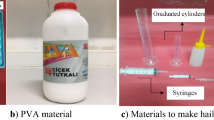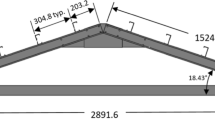Abstract
Residential and commercial buildings often use metal roof panels. In contrast, the dent resistance of steel panel subjected to impact of hailstone is insufficiently studied. The analysis of the whole experimental setup has been carried out using a finite element model (FEM). Artificial hailstones were launched at different steel sheets based on their size at different terminal velocities for comparison with natural hailstones that remained intact after impact. Based on comparisons between experimental results and the FE model, the simulation approach and material properties are evaluated. Additionally, an equation to predict dent depth using kinetic energy and stress is presented. The results of this study provide an understanding of both hail and roof panel failure modes and their effect on dent resistance. Experimental observations and numerical simulations in this study were well matched with results obtained using analytical models. In addition, the proposed equation overestimates dent depths compared with those found in the tested steel sheets, while underestimating the ones determined by finite element models.



























Similar content being viewed by others
Data availability
The datasets generated during and/or analysed during the current study are available from the corresponding author on reasonable request.
References
ABAQUS (2014) Version 6.14 user’s manual. Dassault Systèmes Simulia Corp.: Providence, RI, USA
Kim H, Welch AD, Kedward TK (2003) Experimental investigation of high velocity ice impacts on woven carbon/epoxy composite panels. Composites Part a: Applied Science and Manufacturing 34:25–41. https://doi.org/10.1016/S1359-835X(02)00258-0
Flüeler P., Stucki M., Guastala F., Egli T. (2008) Hail impact resistance of building materials testing, evaluation and classification. Paper presented at the 11 DBMC International Conference on Durability of Building Materials and Components Istanbul Technical University, Istanbul,Turkey, 11 May 2008
Tippmann JD (2011) Development of a strain rate sensitive ice material model for hail ice impact simulation. University of California, San Diego, United States
Allaby M., Garratt R. (2014) Hail, sleet, snow. In: Blizzards. Facts On File. New York
Gold LW (2014) Building ships from ice: Habbakuk and after. Interdisciplinary Science Reviews 29(4):373–384. https://doi.org/10.1179/030801804225018783
Wu Y. (2018) Determining the effects of hailstone impact on flat cold-reduced steel roof sheeting Master of Philosophy thesis, University of Wollongong, Australia.
Uz M.E., Sızar M.D. (2021) Analyzing dent resistance of steel roof panels subjected to hail impacts. Journal of Engineering Sciences and Design 9 (3):1015-1029. https://doi.org/10.21923/jesd.952121
Yilmaz G., Uz M.E., Dawood M., Kop D. (2020) Production of artificial hailstone with liquid nitrogen and comparisons with other artificial hailstones up to now. Journal of Engineering Sciences and Design 8 (4):1180-1189. https://doi.org/10.21923/jesd.672264
Koontz JD The effects of hail on residential roofing products. In: Proceedings of the Third International Symposium on Roofing Technology, NRCA/NIST, 1991. pp 206-215
Timothy P.M., Richard F.H., Scott J.M., Steven R.S. Hail damage threshold sizes for common roofing and siding materials. In: 21st Conf. on Severe Local Storms, Haag Engineering Co. Dallas, Texas, 12 August 2002 2002. pp 1-4
Mohotti D, Ali M, Ngo T, Lu J, Mendis P, Ruan D (2013) Out-of-plane impact resistance of aluminium plates subjected to low velocity impacts. Materials & Design 50:413–426. https://doi.org/10.1016/j.matdes.2013.03.023
Calder CA, Goldsmith W (1971) Plastic deformation and perforation of thin plates resulting from projectile impact. International Journal of Solids and Structures 7(7):863–881. https://doi.org/10.1016/0020-7683(71)90096-5
Perera S, Lam N, Pathirana M, Zhang L, Ruan D, Gad E (2018) Probabilistic modelling of forces of hail. Natural Hazards 91(1):133–153. https://doi.org/10.1007/s11069-017-3117-7
Perera S, Lam N, Pathirana M, Zhang L, Ruan D, Gad E (2017) Use of static tests for predicting damage to cladding panels caused by storm debris. Journal of Building Engineering 12:109–117. https://doi.org/10.1016/j.jobe.2017.05.012
Perera S. (2017) Modelling impact actions of flying and falling objects. The University of Melbourne, Melbourne, Australia. http://hdl.handle.net/11343/194798
Pathirana M, Lam N, Perera S, Zhang L, Ruan D, Gad E (2017) Damage modelling of aluminium panels impacted by windborne debris. Journal of Wind Engineering and Industrial Aerodynamics 165:1–12. https://doi.org/10.1016/j.jweia.2017.02.014
Laurie JAP (1960) Hail and its effects on buildings. Council for Scientific and Industrial Research.
Heymsfield A, Szakáll M, Jost A, Giammanco I, Wright R (2018) A comprehensive observational study of graupel and hail terminal velocity, mass flux, and kinetic energy. Journal of the Atmospheric Sciences 75(11):3861–3885. https://doi.org/10.1175/JAS-D-18-0035.1
Heymsfield A, Szakáll M, Jost A, Giammanco I, Wright R, Brimelow J (2020) Corrigendum. Journal of the Atmospheric Sciences 77(1):405–412. https://doi.org/10.1175/JAS-D-19-0185.1
Knight CA, Knight NC (2001) Hailstorms. In: Vol. 28 of severe convective storms. Meteorological monographs, Boston: American Meteorological Society, pp 223–248
Maguire JR (2014) Experimental determination of the effects of hail impact on steel building envelopes. University of Wollongong, Australia.
Johnson TE, Schaffnit WO (1973) Dent resistance of cold-rolled low-carbon steel sheet. SAE Technical Paper 730528 82(A):1–12. https://doi.org/10.4271/730528
Park H, Kim H (2006) Resistance of adhesively bonded composite lap joints to damage by transcerse ice impact. American Society for Composites - 21st Technical Conference of the American Society for Composites 2006 3:1187-1204
Somasundaram V (2013) The characterisation of hail and fraudulent impacts to vehicle body panels. School of Aerospace, Mechanical, and Manufacturing Engineering, RMIT University, Australia
Anghileri M, Castelletti L-ML, Invernizzi F, Mascheroni M (2005) A survey of numerical models for hail impact analysis using explicit finite element codes. International Journal of Impact Engineering 31(8):929–944. https://doi.org/10.1016/j.ijimpeng.2004.06.009
Sun J, Nelson L, Lihai Z, Dong R, Emad G (2015) Contact forces generated by hailstone impact. International Journal of Impact Engineering 84:145–158. https://doi.org/10.1016/j.ijimpeng.2015.05.015
Kim T, Kuwamura H (2007) Finite element modeling of bolted connections in thin-walled stainless steel plates under static shear. Thin-walled Structures 45:407–421. https://doi.org/10.1016/j.tws.2007.03.006
Carney KS, Benson DJ, DuBois P, Lee R (2006) A phenomenological high strain rate model with failure for ice. International Journal of Solids and Structures 43(25):7820–7839. https://doi.org/10.1016/j.ijsolstr.2006.04.005
Funding
This work was supported by the scientific research projects at Aydin Adnan Menderes University [MF-18004 2021].
Author information
Authors and Affiliations
Corresponding author
Additional information
Publisher’s Note
Springer Nature remains neutral with regard to jurisdictional claims in published maps and institutional affiliations.
Rights and permissions
About this article
Cite this article
Uz, M., Kop, M. & Yildirim, E. Analysis of Out-of-Plane Hail Impact Resistance of Steel Roof Panels. Exp Tech 46, 509–527 (2022). https://doi.org/10.1007/s40799-022-00550-z
Received:
Accepted:
Published:
Issue Date:
DOI: https://doi.org/10.1007/s40799-022-00550-z




